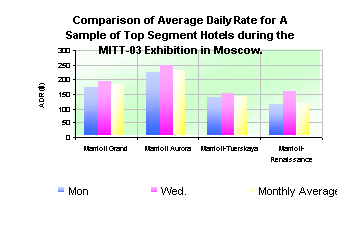2003-04-15
Market Barometer – March
 |
March is a special month for
all of Moscow’s tourism industry. During the first month of Spring, Moscow hotels seek to capitalise on
the flourishing conference and exhibition activity. In this context, it is interesting to analyse the impact that the
exhibition and conference activity carry on hotel performance in terms of
weekly occupancy trends. During the last week of March, the number of room
nights sold constituted on average 80 to 88 % of total room nights available
for the existing mid-tier and upper segment hotels. In most instances, the hotels
enjoyed 4 fill days from the 25th to the 29th of March. |
Before the arrival
of the Spring conference and exhibition season, hotels operate at lower
occupancies. The emergence of conference and exhibition demand in Moscow
provides needed leverage for hotels. Until recently, Moscow was not considered
a popular international venue for conferences and exhibitions. Despite renewed
effort on behalf of the municipal government to stimulate exhibition activity
in the capital, the current exhibitions are characterised by an average
duration of three days. Usually, exhibition patterns in Moscow follow a precise
timing, whereby the exhibitors arrive on a Sunday evening or Monday morning;
set-up occurs mostly on Monday, and the exhibition is then opened to the public
for the remaining three to four days of the week, with all participants returning
either on Friday or on Saturday evening. Thus the occupancy peaks between Tuesday
and Wednesday shouldered by the remaining days of the working week. From this
trend, hotels usually compensate low occupancies at weekends by peak exhibition
related activity at mid-week. Yet, the city of Moscow is still a weak international
venue provider when compared to Cologne, Frankfurt, Milan, Paris or London.
Despite improvement in exhibition organisation in Moscow, the frequency of such
events is still quite sporadic. Among the hotels most involved in the conference
activity, The General Manager of the 777 guestroom Cosmos, Mr. Yulgushev is
deeply concerned about this problem. During the last round table for Moscow
Hotels, Mr. Yulgushev, commented that poor and/or inefficient coordination and
organisation of national exhibitions and conference events negatively impact on
hotel financial performance.
As an example, a
situation was presented, when two large exhibition events were held simultaneously
in Moscow, the largest international tourism exhibition in Russia (MITT-2003)
at Krasnopresnenskaya on the north-western side of the city, and the Textile
Exhibition organised around the BDNXH due north of the city centre. During the
actual duration of the exhibitions, all hotels in the city were fully booked to
the point of turning down exhibition visitors. Towards the end of the exhibitions,
occupancy rates declined. At the weekend, exhibition perks vanished and the
hotels found themselves with occupancy levels falling back between the 30 and
40% range. Obviously, this case illustrates the opportunity cost of poor
coordination. The exhibition planners
should have shifted the second exhibition by 2 to 3 days to enable a smooth
transition from one exhibition to the next. In doing so, all hotels could have
enjoyed twice the amount of related fill days .
As the analysis
shows, during the exhibition, hotels seize the opportunity to raise room
tariffs, thus taking advantage of the great demand for accommodation services
during this time. Basically, this is carried out through the omission of
discounts applicable to sector rates and segment tariffs. This practice on
price policy is most evident among the top segment hotels in Moscow. During the
last week of March, average room rates in 4 and 5 star hotels were 10 to 30%
higher on Wednesday than on Monday.
In lower hotel categories, the impact of exhibition
demand is much less present in the upper segments. During the first exhibitions
in Spring, the average room rates among three star hotels in the city increased
by 3% during the MITT-2003 exhibition in comparison with the previous week.
Rather than raising average rates during one event, this category took the
liberty to raise their prices by 13.5% for March in comparison with February.
| Moscow Hotel Supply |
% Change (March 2002/March 2003) |
Average Daily Rate
|
Average Room Occupancy |
| Top-Segment |
+ 16,3% |
+0,06% |
| Mid-Segment |
+28,5% |
- 12% |
| Lower-Segment |
+29% |
+0,05% |
| Source: HCD Group, 2003. |
As we already
commented in the previous reviews, the Average Daily Rate (ADR) remains one of
the basic performance indicators, which exposes periodic fluctuations in
demand. If we compare average daily rates for the top, middle and lower
segments of the hotel supply in Moscow between March 2002 and March 2003, we
can make the following conclusions.
The analysed tendencies, all things considered, will
continue to impact on the behaviour of the hotel market. The hotels, positioned
in the mid-range and lower segments in Moscow, face lesser competition than
hotels positioned in the 4 and 5 star range. Thus, such hotels have more room
to increase prices, though in doing so, can negatively impact on occupancy and
thus RevPar, as observed in the middle segment with increases in Average Daily
Rate of +28,5 being accompanied with a drop in occupancy of 12%. Thus, we estimate that there is a
correlation between increase in occupancy and average daily rate, whereby
fluctuation in Average Room Occupancy ranging between 65 to 80 % of the
existing hotel room supply will also cause the Average Daily Rate to vary
accordingly by 5 to 10 % per month.
|




